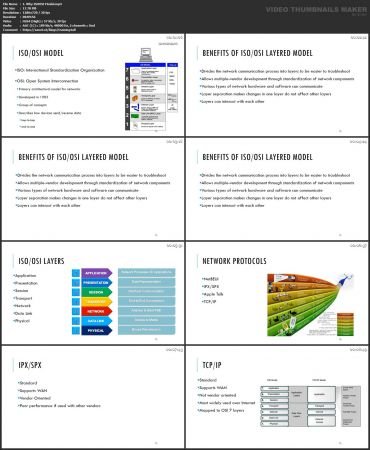|
[ FreeCourseWeb.com ] Computer Networks Security from Scratch to Advanced
Download More Latest Courses Visit -->> https://FreeCourseWeb.com

Video: .MP4, 1280x720 30 fps | Audio: AAC, 48kHz, 2ch | Duration: 08:04:52
Genre: eLearning | Language: English + Subtitles | Size: 894 MB
Computer Networks Security Technologies and Tools for Network Admins and Cyber Security Officers
What you'll learn
Introduction to Computer Networks
ISO/OSI Model (7 Layers)
TCP/IP Protocol Suite
Wireless Networks
Computer Networks Security
Firewalls and Honeypots
Intrusion Detection and Prevention systems (IDS/IPS)
Wireless Networks Security
Physical Security & Incident Handling
Computer Networks Security Recommendations
Requirements
Basic computer knowledge
Basic Internet skills and adequate connection
Beginner networking background
Microsoft Windows machine
Microsoft Power Point for the presentation material
Beginner cyber security information
Laptop machine and standard browser
Description
By the end of this course you will be fully aware of the wired and wireless computer networks basics, devices, and protocols in a step-by-step pace. You will also reach the professional level in networks security in terms of concepts, technologies, and tools. The course requires no background or pre-requisite, yet you will be able to understand all the up-to-date terminologies in the networks security during the lectures.
This course is organized as follows:
Section One: introduction to Computer Networks
Lecture 1: What is a Computer Network?Lecture 2: Computer Networks TopologiesLecture 3: Computer Networks CategoriesLecture 4: Computer Networks Devices and ServicesLecture 5: Computer Networks Transmission Media
Section Two: ISO/OSI Model (7 Layers)
Lecture 1: Why ISO/OSI Model?Lecture 2: Application, Presentation, and Session LayersLecture 3: Transport and Network LayersLecture 4: Data Link and Physical LayersLecture 5: ISO/OSI Model in Action
Section Three: TCP/IP Protocol Suite
Lecture 1: Introduction to Computer Networks ProtocolsLecture 2: IP ProtocolLecture 3: TCP and UDP ProtocolsLecture 4: Application ProtocolsLecture 5: TCP/IP Characteristics and Tools
Section Four: Wireless Networks
Lecture 1: Wireless Networks BenefitsLecture 2: Wireless Networks TypesLecture 3: Wireless Networks Protocol (Wi-Fi)Lecture 4: Wireless Networks DevicesLecture 5: Wireless Networks Drawbacks
Section Five: Computer Networks Security
Lecture 1: Security GoalsLecture 2: Securing the Network DesignLecture 3: TCP/IP Security and ToolsLecture 4: Port Scanning and ToolsLecture 5: Sniffing and Tools
Section Six: Firewalls and Honeypots
Lecture 1: Why Using a Firewall?Lecture 2: Firewalls RulesLecture 3: Firewalls FilteringLecture 4: Honey PotsLecture 5: Bypassing Firewalls
Section Seven: Intrusion Detection and Prevention systems (IDS/IPS)
Lecture 1: What is Intrusion Detection Systems (IDS)?Lecture 2: Network IDS (NIDS)Lecture 3: NIDS ChallengesLecture 4: Snort as NIDSLecture 5: Intrusion Prevention Systems (IPS)
Section Eight: Wireless Networks Security
Lecture 1: Wired Equivalent Privacy WEP AttackingLecture 2: WPA and AES ProtocolsLecture 3: Wireless Security MisconceptionsLecture 4: Wireless Attacks and MitigationLecture 5: Secure Network Design with Wireless
Section Nine: Physical Security & Incident Handling
Lecture 1: Physical Security ObjectivesLecture 2: Physical Threats and MitigationLecture 3: Defense in Depth (DiD)Lecture 4: What is an Incident?Lecture 5: Incident Handling
Section Ten: Computer Networks Security Conclusion
Lecture 1: Confidentiality, Integrity, and Availability (CIA)Lecture 2: Assets, Threats, and VulnerabilitiesLecture 3: Risks and Network IntrusionLecture 4: Common AttacksLecture 5: Security Recommendations
Who this course is for:
Network administrators
Cyber security officers
Computer science undergraduates
Computer engineering undergraduates
Network security postgraduates
Network technical support specialists
Security incident handlers
IT Engineers and CEOs
Software Developers
Web Developers
Mobile Applications Developers
Use Winrar to Extract. And use a shorter path when extracting, such as C: drive
ALSO ANOTHER TIP: You Can Easily Navigate Using Winrar and Rename the Too Long File/ Folder Name if Needed While You Cannot in Default Windows Explorer. You are Welcome ! :)
Download More Latest Courses Visit -->> https://FreeCourseWeb.com
Get Latest Apps Tips and Tricks -->> https://AppWikia.com
We upload these learning materials for the people from all over the world, who have the talent and motivation to sharpen their skills/ knowledge but do not have the financial support to afford the materials. If you like this content and if you are truly in a position that you can actually buy the materials, then Please, we repeat, Please, Support Authors. They Deserve it! Because always remember, without "Them", you and we won't be here having this conversation. Think about it! Peace...


|
|
udp://opentor.org:2710/announce udp://p4p.arenabg.com:1337/announce udp://tracker.torrent.eu.org:451/announce udp://tracker.cyberia.is:6969/announce udp://9.rarbg.to:2710/announc udp://explodie.org:6969/announce udp://tracker.moeking.me:6969/announce udp://tracker.opentrackr.org:1337/announce udp://tracker.tiny-vps.com:6969/announce udp://ipv4.tracker.harry.lu:80/announce udp://tracker.coppersurfer.tk:6969/announce udp://tracker.leechers-paradise.org:6969/announce udp://open.stealth.si:80/announce udp://tracker.pirateparty.gr:6969/announce udp://inferno.demonoid.is:3391/announce |

